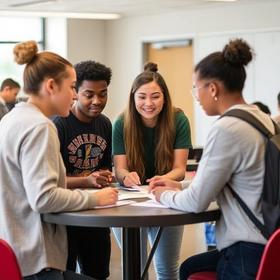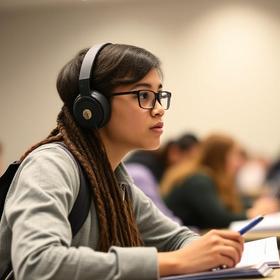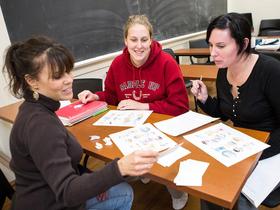Transitioning from a high school environment to a college campus is never easy, but for some students, the change is quite nearly impossible. The difficulties faced can be due to a number of factors. According to a report by Gulf Coast Community College, the reasons that students leave college include having academic difficulties, too many family or job-related responsibilities, not enough money to pay for college related-expenses and a lack of personal motivation to continue with their studies. Additionally, students whose parents did not attend college, and students who have a learning or emotional disability also face challenges as they attempt to get a college education.
However, these at-risk students can successfully obtain a degree. Community colleges across the country have special programs that seek to help at-risk students stay in school. As mentioned in the Gulf Coast Community College report, providing academic guidance services, transition programs for high school students, and targeted interventions for specific at-risk populations are among the most effective interventions colleges can use. Northern Virginia Community College, more commonly known as NOVA, has instituted an innovative program to help non-traditional and at-risk students achieve academic success and even go on to earn a four-year degree. NOVA’s program can serve as a model for what other colleges can and should do to help at-risk students.
This video explains what an at-risk student is.
The Importance of Community College
In the past, community colleges have struggled to provide enough assistance to students who face a number of significant hurdles that make it difficult for them to use college as a springboard to a successful professional life. Students who choose community college may come from challenging economic, social, or educational backgrounds and may be overloaded with financial stresses and family obligations. Many community college students might require some type of remedial coursework, especially in math or English, before they are adequately prepared for the typical college grind. Non-traditional students, such as those who return to school later in life, may have increased family or job obligations that make it difficult to find time to complete all of their coursework.
In 2009, President Obama called on community colleges to become a key player in assisting our country out of the economic slump that gripped the nation. At that time, he unveiled the American Graduation Initiative, which proposed a $12 billion, 10-year plan to invest in community colleges. Many people, like President Obama, saw community colleges as an important resource in training and retraining individuals to get everyone back to work and get the economy thriving once again. Unfortunately, politics played a key role in the initiative being deconstructed. According to a report by Washington Monthly, the initiative ended up being funded for a mere $2 billion, with the first funding not dispersed to colleges until 2011.
However, the importance of community college cannot be understated. The American Association of Community Colleges reports that each year, 13 million students take classes at one of 1,100 community colleges nationwide. These colleges are at the forefront of educating and training tomorrow’s skilled workers and preparing others to continue their education at a four-year institution. Their affordability and adaptability to changing workforce needs make community colleges an integral component of our nation’s higher education system.
This video describes what the Arkansas Community Colleges are doing to help at-risk students be successful.
Pathway to the Baccalaureate
Despite the partial failure of the American Graduation Initiative, community colleges like NOVA are finding ways to help community college students succeed. A former college student who understands all too well the challenges facing many high-risk students today designed NOVA’s Pathway to the Baccalaureate program. Kerin Hilker-Balkissoon grew up in an apartment complex not far from NOVA. When she began her studies at the University of Massachusetts, she nearly flunked out of school after just one semester. Hilker-Balkissoon realized that college students have a difficult transition to make, and she created the Pathway to the Baccalaureate program to help students overcome many of the hurdles she faced during her first year of higher education.
Pathway to the Baccalaureate is a highly structured program designed to help students with the transition between high school and college. It covers everything from basic academic issues, such as how to develop good study skills, to step-by-step instructions on how to register for classes and apply for financial aid. The program follows a number of steps to success:
- Eight transition counselors head to area high schools in search of students who show potential for academic success but lack the necessary support system to achieve it. Nearly 80% of students recruited are accepted into the program – as long as they express a desire to graduate from NOVA and continue their studies at a four-year college.
- Students accepted into the program get to know their counselors through a variety of teaching and social events. These counselors help students navigate the sometimes complex maze of college registration, scheduling, and financial aid applications.
- Once enrolled at NOVA, students are matched with retention counselors who prepare students for academic success on a variety of levels. Counselors also track students' progress and are notified if any student falls below a C-grade average.
- Students are also enrolled in a College Success Skills class that teaches them everything from how to take notes during class to time management and making good choices.
- During the program, students are prepared for the next big challenge of enrolling in a traditional university to earn a four-year degree. Students who successfully graduate from the Pathway to the Baccalaureate program may enroll in a college of their choice, and many choose George Mason University, Virginia Tech, or a host of other nearby universities.
This TEDTalk examines the issue of at-risk students.
Success rates for Pathway to the Baccalaureate thus far are impressive, with most students involved in Pathway achieving better academic success than other students of similar background not enrolled in the program. For example, 72.9% of students in the Pathway to the Baccalaureate program during the 2006-2007 school year earned a GPA higher than 2.0 as compared to just 62.5% of the students who were not involved in the program. During the same academic year, 17.2% of Pathway students had graduated within three years, while only 12.1% of students outside the program had graduated within the same time frame.
There are many reasons to choose community college over a traditional four-year university. According to College Board, some of those reasons might include lack of funds, uncertainty about a field of study, or a GPA that is too low for a student to be admitted to a four-year university. Unfortunately, these same factors can act as obstacles that get in the way of a successful academic career. The good news is that programs like Pathway to the Baccalaureate offer students the support they need to succeed in school and then go on to succeed in their professional lives.
Questions? Contact us on Facebook. @communitycollegereview















